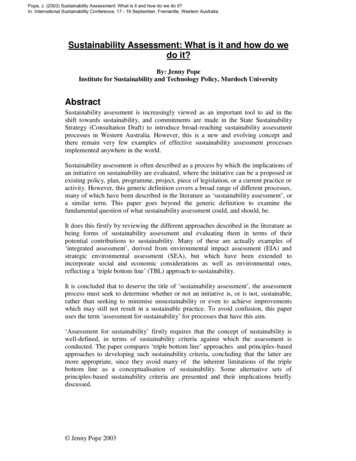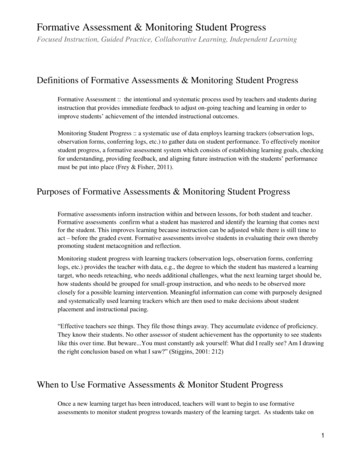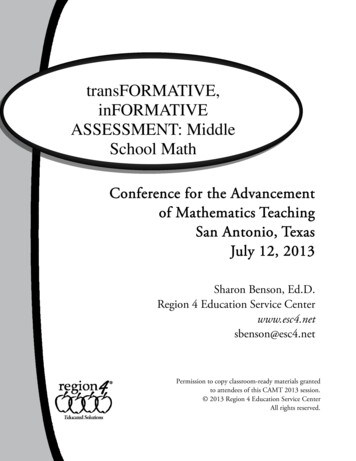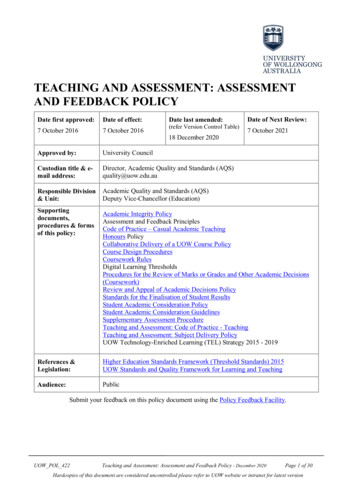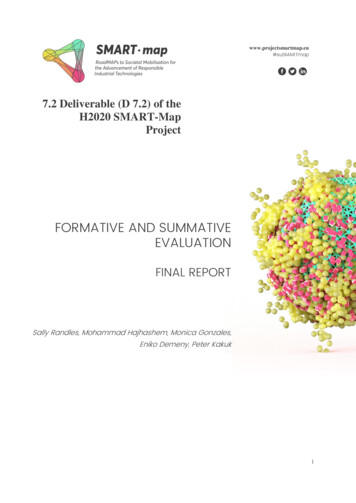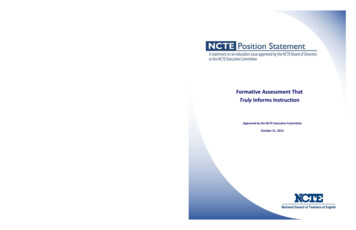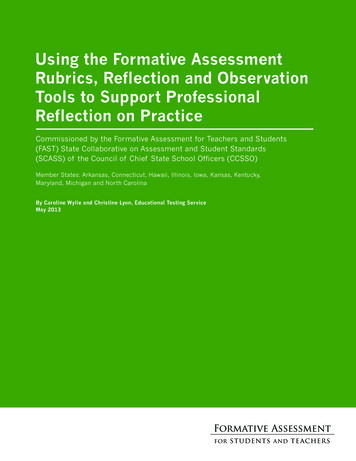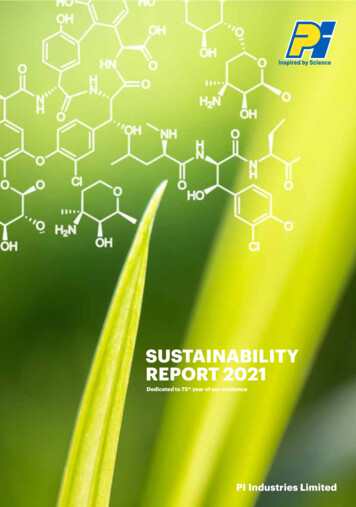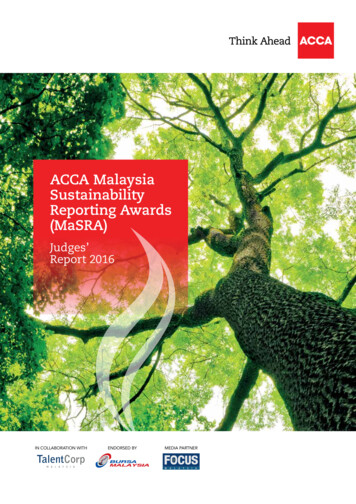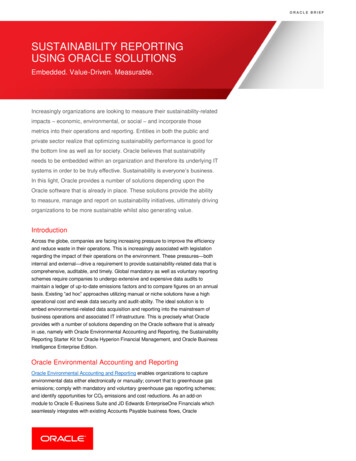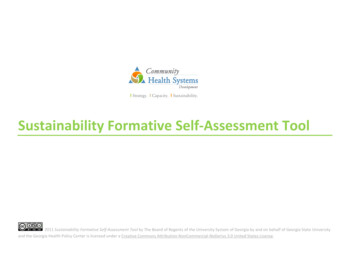
Transcription
I Strategy. I Capacity. I Sustainability.Sustainability Formative Self-Assessment Tool2011 Sustainability Formative Self-Assessment Tool by The Board of Regents of the University System of Georgia by and on behalf of Georgia State Universityand the Georgia Health Policy Center is licensed under a Creative Commons Attribution-NonCommercial-NoDerivs 3.0 United States License.T
What does Sustainability Mean?Over the past decade, sustainability has been a focus for many government agencies and foundations that fund and operate community-based programsand non-profit organizations. Increasingly, organizations and collaborations are concerned with sustaining programs or services beyond initial grant periodsand pilot phases. There are multiple definitions of sustainability used by funders, researchers and community-based organizations. For the purposes of thisassessment tool, sustainability is defined as:Programs or services continue because they are valued and draw support and resources.Sustainability does not necessarily mean that the activities continue in the same form as originally conceived, funded or implemented. Programs oftenevolve over time to adjust to the changing levels of support and needs of the community. Organizations may start with one approach, but ultimately electto sustain a different model of service provision after testing it in the community.What do Sustainable Programs Have in Common?Sustainability is not random luck, nor can it be achieved through a prescribed set of actions. It is important to recognize, however, that sustained programsand organizations appear to have some attributes in common. Based on our experience working with more than 800 rural health initiatives and findingsfrom our study of 102 sustained rural health initiatives, the Georgia Health Policy Center has developed a Sustainability Framework . This frameworkdescribes nine areas of strategy, capacity, and action that help to position an organization or program for sustainability (included as an attachment to thisdocument).1. Strategic Vision6. Capacity2. Collaboration7. Efficiency & Effectiveness3. Leadership8. Relevance and Practicality9. Resource Diversification4. Communication5. Evaluation and ROIT
It is useful to familiarize yourself with the Sustainability Framework prior to beginning the self-assessment process. The key to understanding eachcomponent is to put it into the specific context of sustainability. As you read through the Sustainability Framework , consider how each element mayenhance the long-term potential for a program, organization or activity. Leadership, for example, has many applications and benefits. Leadership inthe context of sustainability means that you have created a shared vision, have leaders within your team that see the relationship between short-termactivities and long-term outcomes, and that you have engaged leaders that will exert their influence in leveraging support and locating resources.Why do a Formative Assessment?At the core of a formative assessment is the goal to “form” or improve. This is a different purpose than that of summative assessments. In a summativeassessment, you are being evaluated on the end result, or “sum,” of your efforts.Both are very useful. Formative assessments are particularly helpful in determining progress and identifying areas to concentrate efforts while there isstill time to influence the end result.Additionally, formative assessments are designed around rubrics - sets of criteria and standards organized into levels thatestablish a continuum of increasing expectations of quality. can be used to chart change over time. present a clear path for attaining greater levels of quality and performance.Are We Positioned for Sustainability?The Sustainability Self-Assessment Tool may serve multiple purposes: To capture your general level of functioning related to elements of the Sustainability Framework ;To provide guidance as to what activities or capacities are indicative of improvement or movement along the developmental spectrum;To isolate or highlight areas where continued work or development might be needed; andTo provide a baseline against which change (positive or negative) can be viewed over time.
For each component of the Sustainability Framework , developmental rubrics have been described for each level of performance in atable format. These rubrics are not intended to be definitive, meaning you are not necessarily expected to fit each description perfectly.Rather, they are provided to illustrate a continuum along which you might progress with higher levels of performance – giving you an ideaof what “improvement” or growth in a particular area might look like.Before you conduct the self-assessment, take a moment to review the terms used in the tool’s rubric. Each item will ask you to rate yourorganization/network/consortium in one of four levels. A general description of these four levels is provided in the table below. For eachlevel, the one-letter code provided should be used to record your results on the group result chart on the Summary of Results page of theassessment tool.LevelDescriptionPre-Awareness PNot yet aware of the importance of the element and/or its relationship tosustainabilityAwareness AAware of the importance of the element, but may not have sufficientcapacity (e.g., not know how to solve the issue) or motivation (e.g., waitingfor leadership and/or direction to address the issue)Interaction IAware of the importance and have translated available “know-how” andmotivation into some sort of initial action on the component; there isevidence of impact on the component in limited ways, though results arelikely limited and inconsistentMastery MAware, capable, and strategic in their actions. Worthy of being a model inhow to address the component for others.
Current StatusComponent: Strategic VisionThe organization has a clearlydefined vision for what it hopes toachieve Component: CollaborationPartnerships include stakeholdersnecessary for the successful planning,implementation, and or continuationof programs and servicesPartners play an integral role andhave a shared interest in theoutcomes Vision is developed inisolation of partners Activities are notdefined orimplemented inreference to statedvision All those associated with organizationshare its visionAll activities are aligned with visionPre-AwarenessOrganization views allprogram activities asshort-term in natureAwarenessOrganizationrecognizes need forlong-term planning,but remains focusedon short-term programimplementationVision is developedwith limited inputfrom partners and nocommitmentActivities are orientedto address specificissue but are notaligned with any longterm vision InteractionOrganization has longterm concept forspecific programimplementationPartners participate indevelopment of vision,but withoutorganizationalcommitmentAll activities areoriented to a specificissue and some arealigned with a longterm vision MasteryOrganization viewsprogram as part oflong-term approachfor systemic change All partners develop,share, and arecommitted to vision All activitiescontribute to fulfillinga long-term strategicvisionCurrent StatusPre-Awareness Partnerships formed inorder to fulfill fundingAwareness Partnerships are based onprevious relationships thatmay or may not beappropriate to address theproblem Lead organizationperforms all programactivities and retains allfinancial resources Lead organizationperforms most programactivities with participationby some partnersInteractionPartnerships areassessed and expandedto includeorganizations that canaddress the problemMastery Partnerships include allorganizations needed tostrategically address theproblem Most partners engage inprogram activities, someresources are shared amongpartners Partners jointly makedecisions about overallprogram direction andutilization of resources andhave a shared interest inproject outcomes
Component: LeadershipInspires others to create andachieve a shared visionUnderstands the relationshipbetween short-term activitiesand their impact on long-termsuccessCurrent StatusPre-Awareness Leadership operatesindependently toimplement the workplan with no strategicinvolvement fromothersAwareness Leadership engagespartners in short-termproblem-solvingfocused on work planimplementationInteraction Leadership engagespartners in developingstrategies for long-termsuccessMastery Leadership engages others to define,accomplish, and sustain its visionthrough a shared sense of responsibilityby creating an environment ofcollaboration and enthusiasmExerts influence in leveragingsupport and resourcesCurrent StatusComponent: CommunicationThe organization defines perceptions,translates successes, and createsawareness through effectivecommunication Information is exchanged amongpartners and stakeholders throughstructured and informal channels. Pre-AwarenessOrganization has noplan forcommunicatingprogram to thecommunity, andfunders and otherstakeholders areunaware of programCommunication islimited to one-on-oneinteraction betweenlead agency andpartners as needed AwarenessOrganization makesuse of some publicmedia (e.g., pressreleases, newsletters)and other methods onan ad hoc basis toupdate the communityon its programactivitiesCommunication andinteraction amongstpartners occurs onlyduring infrequentmeetings InteractionOrganization regularlyuses public media andother methods toupdate the communityon both its activitiesand programeffectivenessPartners communicateamongst themselvesduring regularlyscheduled meetings MasteryOrganization hasdeveloped targetedmessages and acommunicationsstrategy thateffectively utilizesavailable mediachannels to buildawareness and publicsupport for programPartners andstakeholdersproactively initiatecommunicationamongst themselves
Component: Evaluation &“Return on Investments”Current Status Pre-AwarenessThere is no evaluationplan in support of theprogram Evaluation generates data necessaryto: monitor and manage programimplementation, measure program impact, and demonstrate social, economic,and/or health benefits to communityserved.Component: CapacityOrganization has adequate capacity tocomplete programs based on: Personnel with necessary skillsand knowledge, and Experience with projects ofsimilar scope or focus.AwarenessEvaluation activitiesgenerate data that areused to monitorprogram activities InteractionEvaluation activitiesgenerate data that areused to:monitor programactivitiesinform and adjustprogramimplementationmeasure programimpact MasteryEvaluation activitiesgenerate data that areused to:satisfy funder’sreporting requirementsmonitor programactivitiesmanage programimplementationmeasure program impactdemonstrate social,economic, and/or healthbenefits to communityservedCurrent Status Pre-AwarenessOrganizational staffand experience do notmatch the magnitudeor focus of theproposed program AwarenessOrganization has anunderstanding of thenecessary staff andexperience in order toimplement a similarprogram InteractionOrganizationunderstands necessarystaffing levels andcapabilities and hasexperience inimplementingunrelated programs ofa similar magnitude MasteryOrganization has atrack record ofcompleting programsof similar magnitudewithin budget and ontime
Component: Efficiency &EffectivenessOrganizational operations maximize theability of those being served to participateand produce intended resultsProgram approach is based on thesuccesses and challenges of similarinitiativesOrganization draws from and contributesto existing community resourcesCurrent StatusPre-Awareness Those being served arenot consulted in programdesign and implementationAwareness Feedback from thosebeing served has littleinfluence on programdesign and implementation Programs developedwithout knowledge ofevidence based programsor consultation with othersimilar successfulprograms Program services operateindependently of otherrelated communityinitiatives Programs developedwith cursory understandingof similar initiatives Program services drawfrom and offer limitedsupport to other relatedcommunity initiativesInteraction Feedback gainedthrough formal methods,such as surveys and focusgroups, is used to guideprogram design andimplementation Programs developedfollowing consultation withothers who haveimplemented similarprograms Program providesunique and complementaryservices to the communityMastery Those receivingservices have anintegral role inprogram design andimplementation Programs are derivedfrom evidence-basedinitiatives Program has anintegrated role in theprovision of services inthe community; othersrecognize and supportthat role
Component: Relevance andPracticalityCurrent Status Approach based on a clearassessment and understanding of theneedThe approach does nottake into accountcontextual factors thatmay inhibit orfacilitate successfulimplementation (e.g.geography, policies,local culture) The approach is notrelevant or practicalgiven the complexityof the problem The approach is likely to accomplishdesired impact because it takes intoaccount the magnitude or complexityof the problemOrganization receives diversity ofsupport generated throughsustainability planning Approach tailored to theenvironment (cultural, political,economic)Component: ResourceDiversificationPre -AwarenessOrganization notaware of informationor data to demonstratethe need for thestrategy/approachAwarenessOrganization utilizessome state andregional data todemonstrate need forlocalstrategy/approachOrganization is awareof some keycontextual factors thatmay affectimplementation of thestrategy/approach, butthey have not takenaction to address thosefactors in theirimplementation planThe approach is a stopgap measure to serveshort-term needs withno attempt to addressmultiple aspects orroot causes of theissue InteractionOrganization utilizespast CommunityNeeds Assessment andregional/state data todemonstrate need forstrategy/approach MasteryOrganization usescurrent CommunityNeeds Assessment andregional/state data toshape implementation ofstrategy/approach Organization hasidentified somecontextual factors thatmay affectimplementation andare taking action todeal with those factors Organization exhibitsdeep understanding ofthe context within whichthey operate and hasdesigned an approachthat takes into accountcurrent contextualfactors The approach ismatched appropriatelyto the complexity ofthe problem beingaddressed. For morecomplex problems, theapproach is multipronged/ integrated The approach wasdesigned with a deepunderstanding of theroot causes of theproblem at hand anduses leverage to addressthe issue in acomprehensive mannerCurrent Status Pre-AwarenessProgram supported bya single fundingsource; does notengage insustainability planning AwarenessProgram supported bymore than one sourcewithout benefit ofsustainability planning InteractionProgram supported bya variety of sourcesdeveloped through anad hoc approach tosustainability planning MasteryMultiple sourcescontribute adequatefunding for long-termprogram continuation;support generatedthrough formal, ongoing sustainabilityplanning
T Sustainability Formative Self-Assessment Tool . 2011 Sustainability Formative Self-Assessment Tool by The Board of Regents of the University System of Georgia by and on behalf of Georgia State University and the Georgia Health Policy Center is licensed under a . Creative Commons Attribution-NonCommercial-NoDerivs 3.0 United States License
